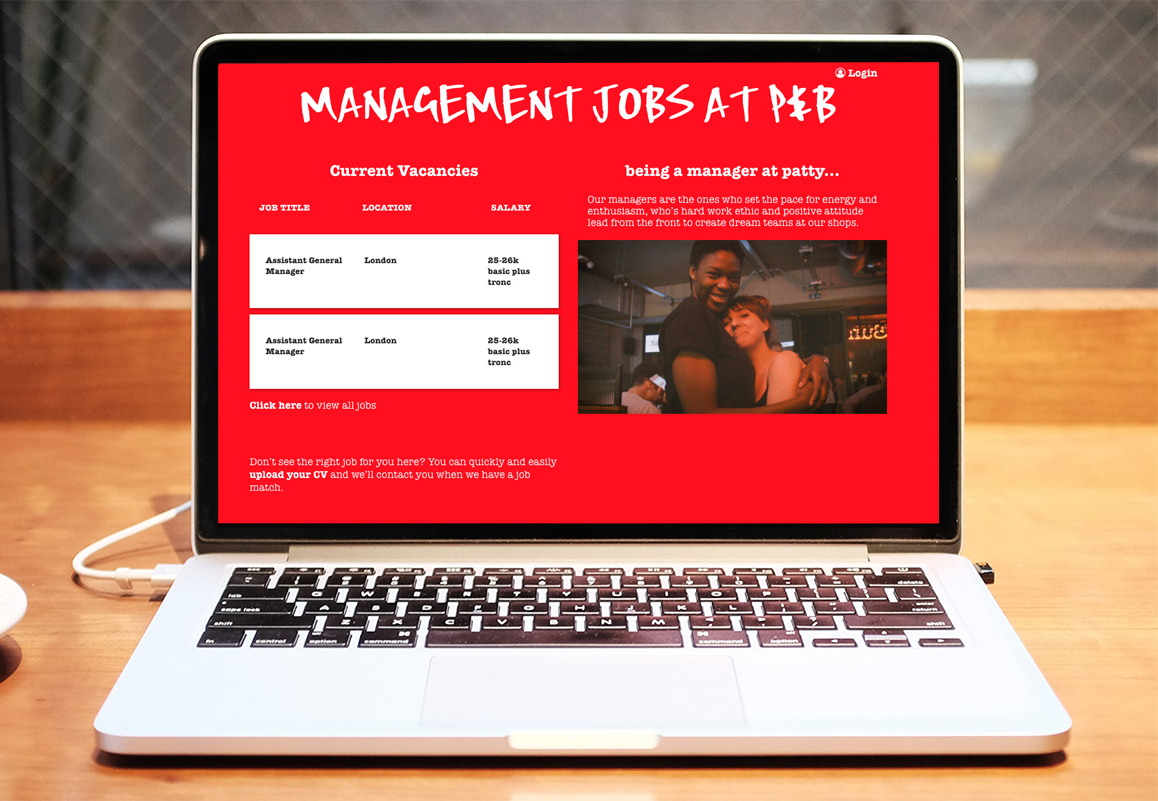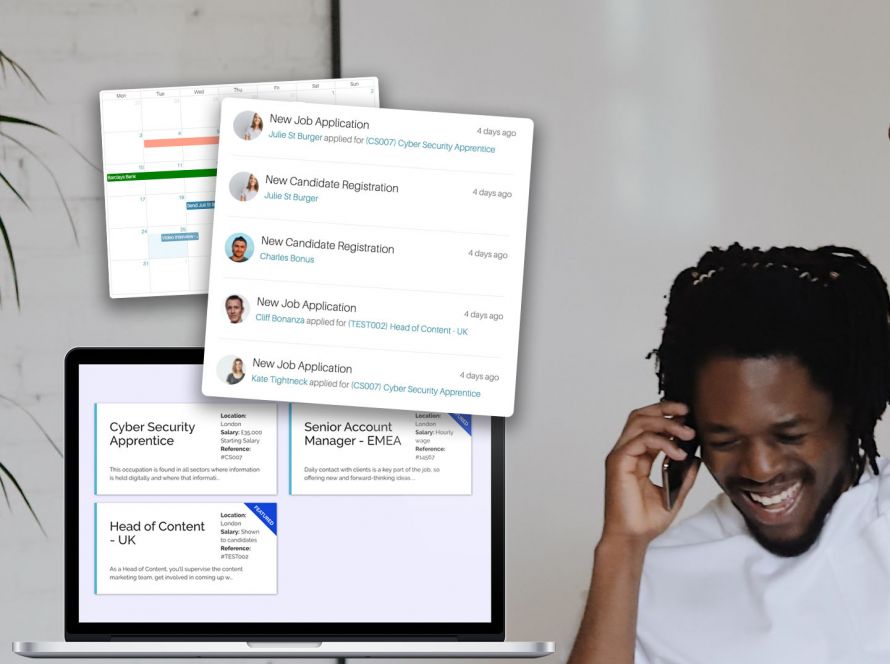
Careers Pages are like your own in-house recruitment agency working 24 hours a day, 365 days a year, helping you to source and convert the right talent to grow your business.
- 64% of job seekers agree that a rich careers page on an employer’s website is a valuable resource when searching for employment.
- When done right, great career pages have enough information and flavour for prospects to self-select if they are a good fit. The best pages attract a variety of relevant candidates, framing their early idea of what it would be like to work with you.
What to include?
To successfully engage potential candidates, careers pages needs to be dynamic. The page should include videos, photos and employee testimonials, all with clear call-to-actions that prompt the visitor to view and apply for the open roles.

Specifically, careers pages should describe:
- Company values
- Your team
- Your work environment
- Your job roles
How to make the ultimate careers page:
Be hard to miss
- To attract job seekers to the careers page, search engine optimisation (not buzzwords) should be used to increase the website’s likelihood of being searched.
Engage the viewer
- The majority of people have a short attention span, so to spark interest quickly and keep people in tune, powerful, thought-provoking headlines along with images and videos are vital for effective careers pages.

Convince qualified candidates
- Good content, functionality, and design are key ingredients of successful careers pages. In order to lure qualified candidates, the website should be specifically designed to intrigue and attract your target demographic.
Simple is best
- Job search functionality should use filters to narrow the candidate’s search to jobs in their area and desired sector. If candidates can’t quickly match themselves to relevant jobs they will simply move on. Keep in mind that candidates are not looking for hundreds of jobs, they are looking for just one – their next job.
- Recruitment software such as Recsite can also offer dynamic candidate registration which parses a candidate’s CV/Resume file and quickly builds a custom profile in just a few minutes. Candidates will then be recommended jobs that match their skills and preferences at the end of the registration process helping to maximise applicant conversion. This can be useful for times when you don’t have active jobs to advertise but you are still looking to build your talent pool.
Be realistic
- Well-designed careers pages act as a filter for any potential job candidates. The more authentic and realistic you can be about working at your company, the higher the chance of attracting the right type of candidate to your business. Concentrate on the perks of each role, but don’t overglamorise.
- Whilst viewing the careers page, candidates also want to know as much as possible about their future workspace. It is important to include the location of the offices, the way in which they’re designed (meeting rooms, office-space) and what technology is being using. Prospective candidates also want to know if the company has adopted hybrid work, with this being a commonly desired trait for when job searchin.
Celebrate diversity
- Careers pages should feel welcoming to job seekers from all walks of life; races, genders, ages and experience levels. This can be reaffirmed through the use of photos of your team, and by providing a link to your diversity and inclusion statement.
Use an automated hiring system
- Recruiting software can make the overall hiring experience much more effective. It’s particularly beneficial to implement a talent acquisition solution with a sturdy candidate portal; providing candidates with a centralised location to apply for specific jobs, future opportunities as well as review and respond to interviews invitations and document signatures.
Keep it mobile friendly
- According to Glassdoor, 89% of job seekers say their mobile device is an important tool for job searching, and 45% use it to search for jobs at least once a day. Having a mobile-friendly careers page is a crucial gateway for prospective candidates, providing a chance to attract and refine good candidates
Here are a few ways to make your careers page mobile-friendly:
- Organise text – Use lists, images or graphics , when appropriate to make the well-structured text friendlier to the reader’s eye.
- Pay attention to UX – eliminate any unnecessary links and pop-up windows.
- Use a responsive design – this will adjust the orientation and screen size of the careers to the device the viewer is using.
See below – a good example of a mobile-friendly responsive design from thefixcreative.co.uk:

Communicate with candidates after applying
- A large number of job seekers will never hear back from the employer after applying for a position. By using a careers page embedded ATS system to manage applications, candidates can be kept engaged with feedback through the entire recruitment cycle, providing them with the consideration they deserve.
- Through the speediness of the AI-powered algorithm that the ATS serves, candidates can be immediately categorised with a job where they meet the requirements, allowing for the best talent to be discovered. With this skeeled solution, you can form a great, fully branded and integrated careers page to funnel applicants all through one simple tool.
- Keep in mind, a candidate may be wrong for a certain job but absolutely right for another, future vacancy. Always show courtesy to your candidates and you will find that future staffing issues can be solved before they occur.
Job postings are kept up to date
- It is important to take down jobs that have been filled and post any new jobs on the platform. Provide users with an option to be notified if aren’t any open positions.
To conclude, careers pages are one of your best tools for attracting the right type of candidate to your business. It is worth investing time and money to ensure you build a sustainable talent pipeline that can help your business prosper in the new reality of work.
How do I increase visibility in search results via the careers page?
Careers pages must be SEO-friendly – don’t list job titles that are too complex or distinctive like “Chief Coffee Machine Operator” or “Happiness Consultant” as the results will be bad.
How can I strengthen employer branding through job postings?
Job descriptions should pique the interest of visitors and incentivise them to apply for roles. They should be clear and true to role being advertised. Avoiding inconsistencies in this process will remove any disillusioned feeling among applicants.
How can I make the process of applying for a job as simple as possible for the job seeker?
By strategically placing “apply now” buttons across the careers page in the most suitable places, you can engage the prospective candidate and help them decide as easily as possible.
What is a skeeled solution?
An AI powered tool to help boost your recruitment process.
How can I make the careers page as optimal as possible for mobile?
Include readable fonts, user-friendly forms, and clear content balanced with eye-catching visuals. Design with strictly relevant and qualifying questions and quick application forms.
My company already has a good recruiting system in place, why should I get an automated hiring system?
As stated previously, recruiting software can make the overall hiring process much more effective. Recruiting software can also integrate with other tools such as web forms, job boards and Linkedln apply – this lets applicants use their Linkedln data to directly apply for jobs, thus speeding up the whole process.
Why do I need to give my careers page the “human” element if it already has personality?
Describing the culture of your organisation is not enough. Throw the spotlight on your team – their stories, photos, videos and testimonials.
Should I add any text to a video/image?
Videos are hard to summarise without watching in their entirety. Balance videos with helpful text, as readers may skim a text but still capture its main points.



